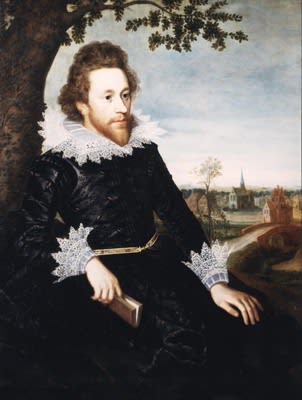
Anglo-Flemish School
Portrait of a gentleman, c. 1620
Oil on panel
43 1/4 x 35 1/3 in. (110 x 89.75 cm)
Philip Mould & Co.
To view all current artworks for sale visit philipmould.com This portrait of a young man sitting against a tree before a - perhaps imaginary - Flemish town is an interesting...
To view all current artworks for sale visit philipmould.com
This portrait of a young man sitting against a tree before a - perhaps imaginary - Flemish town is an interesting expression of themes in portraiture that had begun to emerge towards the end of the sixteenth century and were to remain a consistent part of its language for the next two hundred years. There is an attempt to integrate the sitter with his landscape surroundings, and to suggest that beyond the simple employment of a backdrop he might really be reading a book in a grove just outside a town. The mood, of course, is one of gentle melancholy. The sitter's costume of an impeccably tasteful and aristocratic black assists the mood, as does the book that it ignored for a moment's reflection. This motif of the book held with a finger marking the place becomes the stock-in-trade of a great many later rococo portraits, where it confers education and discernment upon its subjects. Even the gentle melancholy remains within the repertoire of later painters.
Equally of its time, however, and as suggestive as the sitter's face of an English influence, is the meticulous - almost miniaturist's - attention to the details and fabric of the costume. With exquisite care the artist distinguishes the many shades of black that make up the silk sheen of the doublet and contrasts them with the flashes of crimson visible through the slashing. It is a technique reminiscent of the draperies of such contemporary English painters as Henry Larkin.
This portrait of a young man sitting against a tree before a - perhaps imaginary - Flemish town is an interesting expression of themes in portraiture that had begun to emerge towards the end of the sixteenth century and were to remain a consistent part of its language for the next two hundred years. There is an attempt to integrate the sitter with his landscape surroundings, and to suggest that beyond the simple employment of a backdrop he might really be reading a book in a grove just outside a town. The mood, of course, is one of gentle melancholy. The sitter's costume of an impeccably tasteful and aristocratic black assists the mood, as does the book that it ignored for a moment's reflection. This motif of the book held with a finger marking the place becomes the stock-in-trade of a great many later rococo portraits, where it confers education and discernment upon its subjects. Even the gentle melancholy remains within the repertoire of later painters.
Equally of its time, however, and as suggestive as the sitter's face of an English influence, is the meticulous - almost miniaturist's - attention to the details and fabric of the costume. With exquisite care the artist distinguishes the many shades of black that make up the silk sheen of the doublet and contrasts them with the flashes of crimson visible through the slashing. It is a technique reminiscent of the draperies of such contemporary English painters as Henry Larkin.
Provenance
Frederik Muller, Amsterdam, 1913 no.59Be the first to hear about our available artworks
* denotes required fields
We will process the personal data you have supplied in accordance with our privacy policy (available on request). You can unsubscribe or change your preferences at any time by clicking the link in our emails.